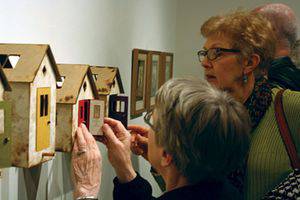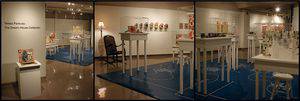This artist book installation by Teresa Pankratz ’78, Chicago, was on display in the Fine Arts Center Gallery Jan. 16–Feb. 14.
The series of photos at left gives an idea of the spread of The Dream House Collection
inside the Fine Arts Center Gallery. Photos by Teresa Pankratz.
After Teresa and her husband, Bryan Saner ’79, spent several days putting the installation together, Teresa remained in the area for another week. During that time, she was a guest presenter in the Book Arts class that Rachel Epp Buller ’96 taught during interterm, and did three live narrations of The Dream House Collection’s principle text, The View From a House in Kansas, Acts 1 to 5.
The performed readings incorporated musical interludes on toy piano and old-time radio sound effects. As an artist creating text-based work,
Teresa says, I’m committed to the revolutionary expansion of ways readers/viewers access text in a gallery setting.
From Teresa’s artist statement:
To step into The Dream House Collection is to enter the remains of a lost home—a floor plan recalled in sleep and filled with scavenged ‘evidence’—accumulations invoking the existence of … three fictional adult siblings whose lives are transformed when their childhood home burns to the ground.
Displayed under glass and situated on a room-size blueprint floor, eleven print and object-based narrative sculptures and artist’s books make up The Collection’s nucleus. Two- and three-dimensional wall-mounted sculptures, drawings and prints draw the reader/viewers to the parameters of the installation.
 Darlene Dick ’69, right, and Erna Rempel ’62 look at the row of little houses that can also be seen on the wall at left. An artist book installation is meant to be interactive, so visitors were invited to open the houses to see the objects inside and read the text on the insides of the doors.
Darlene Dick ’69, right, and Erna Rempel ’62 look at the row of little houses that can also be seen on the wall at left. An artist book installation is meant to be interactive, so visitors were invited to open the houses to see the objects inside and read the text on the insides of the doors.These 25 works collectively explore the relationship of the individual to the loss of the sheltering structure called ‘home’—and the material culture housed there. Homeless objects, phantom spaces and tales recalling a mid-20th-century childhood expose constrictive middle-American ideologies and bear witness to the dreams and memories of the children. … Like images framed in a graphic novel, these artifacts assemble themselves to reveal a collective tale.
No matter how virtual our lives increasingly become, we exist within a concrete world. Day to day, we deposit traces of identity in the things we use and the places we inhabit, establishing intense physical, emotional and intellectual connections.
Framed within a feminine/feminist context, I work to give voice and presence to these connections, endeavoring to push my inquiry beyond nostalgia into realms of recognition and revelation. I investigate these domestic space and object repositories with juxtapositions of text, image and form, considering not only their physicality, but associated facts, fictions, dreams, and imaginings.
My goal is the visible communication of narrative.
I believe in the possibility born of the act of making. Through the manipulation of writing, drawing, print media (digital, letterpress, intaglio, relief), bookbinding, sculpture and paper engineering techniques, I believe it is possible to draw the viewer into a newly crafted reality.
In my work, found and handmade objects can wear narrative labels, open like books to reveal inner stories, and become wrapped up in words—in this reality, it might be possible to take a second look and read the familiar in a new way, encountering, perhaps, a moment of transformative potential.
